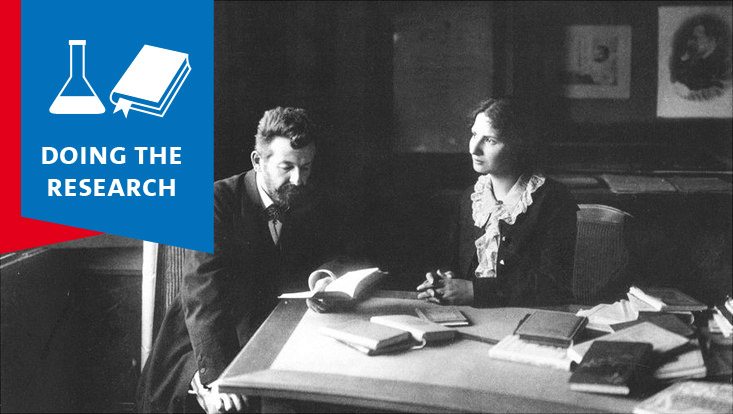Digital humanities:Ida and Richard Dehmel—Modernity’s InfluencersDoing the Research series
18 August 2022, by Anna Priebe

Photo: Louis Held / public domain
Between 1890 and 1920, the artist couple Ida and Richard Dehmel corresponded with renowned artists such as Stefan Zweig, Rainer Maria Rilke, Else Lasker-Schüler, and Arnold Schönberg. Prof. Dr. Julia Nantke is researching the 35,000 handwritten documents in her project Dehmel Digital and making them publicly available. Our series Doing the Research introduces research projects at Universität Hamburg.
A married couple writes letters at the dawn of the twentieth century. Why is that interesting for the lay person?
Many cultural aficionados interested in the Dehmel’s exciting life at the center of modern art around 1900 visit the Dehmelhaus, a memorial site in the Blankenese district of Hamburg. Currently, however, they can only admire the “shell”—the house itself and its furnishings, which give only an inkling of the original atmosphere. Their letters, however, bring their personal network, their interests, their shared projects, and even their parties to life. Thus, we are planning to bring their letters to the Dehmelhaus. Anyone who sees one of Peter Behrens’ pictures on the wall there, for example, can then read letters from Behrens directly, in which he sends the Dehmels his design proposals.

To what extent does your project, which can be assigned to the digital humanities, go beyond just scanning the letters?
Actually, we are not even really scanning them in this project. We are already receiving the digital versions from our project partner, the State and University Library Carl von Ossietzky. We will make these digital documents readable for the general public using computer-based procedures and then identify the people, places, works, and organizations named in them.
To do do, we are using various machine-learning procedures because that is faster and more efficient. We will feed the findings into the University’s research data repository. At the same time, we will present the parts we have analyzed on the dehmel-digital.de portal already available online in a beta version and which we will regularly update with new material.
What is the special challenge for this project?
Definitely the sheer amount of material and thus the necessity of developing a new procedure to study it: 35,000 letters can no longer be handled using classic approaches to study and publishing, which are based on thorough interpretation and manual processing of each and every letter.
That’s why in this case we are treading new paths with machine learning, which, in turn, poses its own challenges. We will be using statistical, computer-based procedures to transcribe the handwritten letters (Handwritten Text Recognition—HTR) and to identify the relevant entities such as people and places (Named Entity Recognition—NER). There is thus always a certain margin of error for the findings. We will, of course, make corrections but managing the amount and ensuring precision will be a balancing act.
Without the statistical procedure, we couldn’t even begin trying to deal with such a large quantity of material.
How can we imagine the statistical procedure for studying handwritten texts?
We are using supervised machine learning. The algorithms learn to recognize the handwriting and people, places, works, etc. using training data that we supply. For this, we have correctly digitalized a few handwritten letters ourselves. Using these examples, the artificial neuronal network learns the “rules” for translating the handwriting in a transcript.
For example, we are concerned with the various forms a letter can take and how it connected to the various previous and subsequent letters, whereby we always check to ensure that prior training data are not simply memorized but that the rules are actually “understood.”
What is the advantage of digital humanities for the study of such complex collections of writing?
As our project clearly shows, without the statistical procedure, we couldn’t even begin to deal with such a large quantity of material. Digital humanities procedures make it possible to look at the entire archival collection rather than just a part of the corpus, and thereby to make the entire network of people and organizations in the background visible for posterity.
And when it comes to presentation, the digital format is very advantageous because it’s hardly possible to publish 35,000 letters in printed volumes. On our online portal, we can make the material available to users in a structured way, using illustrations, linked registers, and structured searches and, if necessary, allow them to download individual letters, larger excerpts in the corpus, or the entire collection as an XML to work on further.
Have you found anything out about Richard and Ida Dehmel that the research had not previously uncovered?
It is especially exciting to see from the correspondence the collaboration involved in literary and artistic work and in the cultural sector, with constant dialog between colleagues: drafts of poems and sketches are sent back and forth, commented on, and in some cases, worked upon further by correspondence partners. The letters reveal Richard Dehmel’s advocacy for the fair payment of poets, which he attempted to achieve alongside other poets such as Arno Holz and Detlev von Liliencron by founding the Cartel of Lyric Authors, as surely as they reveal Ida Dehmel’s alliance with Rosa Schapire in the Women’s League for the Promotion of the German Visual Arts.
Project
In the period prior to World War I, Richard Dehmel was considered one of the most important German-speaking poets. Together with his wife, Ida—a women’s rights advocate and patron of the arts—he established an international network of artists in the Blankenese district of Hamburg. The project Dehmel Digital will set up an accessible digital platform for the study of the Dehmel’s extensive correspondence. In cooperation with the State and University Library Carl von Ossietzky, roughly 35,000 original letters written by the Dehmels as well as the their archived replies will be partly automatically transcribed using digital tools. Dehmel Digital received seed financing from the Faculty of Humanities at Universität Hamburg and has been funded by the Hermann Reemstsma Foundation since 2020.
Doing the Research
There are approximately 6,200 academics conducting research at 8 faculties at Universität Hamburg. Many students also often apply their newly acquired knowledge to research practice while still completing their studies. The Doing the Research series outlines the broad and diverse range of the research landscape and provides a more detailed introduction of individual projects. Feel free to send any questions and suggestions to the Newsroom editorial office.


